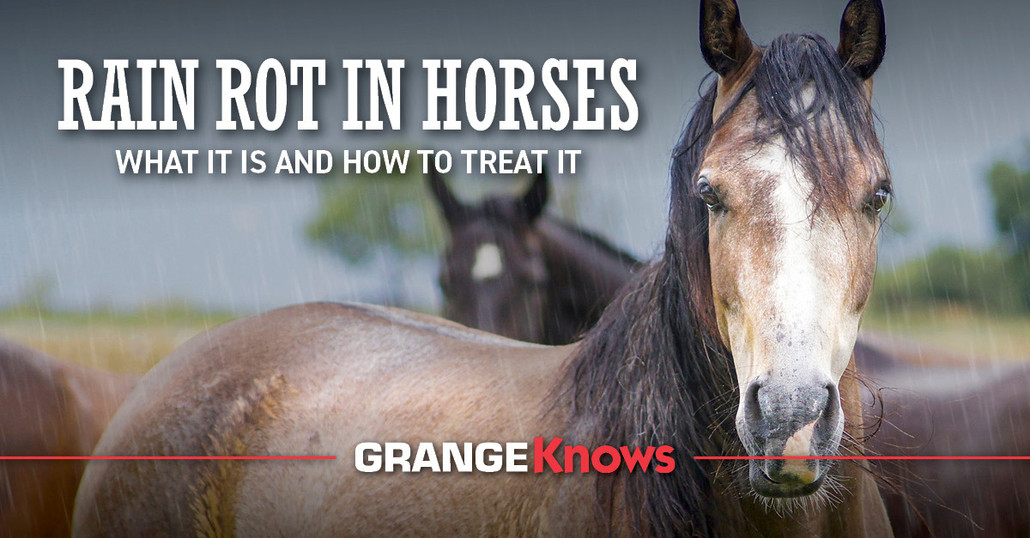
Rain Rot in Horses — What It Is and How to Treat It
Posted by Grange Co-op on 21st Feb 2023
Nothing is more beautiful than seeing a horse running in the field. But when horses spend a lot of time outdoors during wet weather, they can develop rain rot that spoils their good looks and threatens their health. Rain rot is a common condition that isn't limited to neglected horses. Even the most diligent owners will see the condition in their horses at some time, especially during periods of rainy weather.
What Is Rain Rot?
Rain rot, also called rain scald, is a bacterial skin infection caused by Dermatophilus congolensis. The bacterium lives dormant on the horse's skin until it is exposed to wet conditions. Wounds or insect bites provide an entryway into the horse’s system, initiating infection by the bacteria.
Prolonged saturation with water weakens the surface layer of the skin, making it more vulnerable to infection. The bacterium moves around in the moisture causing the infection to spread to other areas. The rain rot might start in one or two small areas and grow to include larger areas of the horse's skin.
Extended exposure to rain is often the reason that dermatophilosis occurs. But keeping horses covered with a blanket that doesn’t breathe can also cause the condition. When the horse sweats, there is no way for the moisture to escape. This creates the ideal environment to develop the skin condition.
Failing to treat rain rot in horses can lead to a more serious condition that causes pain, fever, and loss of appetite. It’s important to understand what rain rot is and how to treat your horses when it occurs.
Rain Rot vs Dew Poisoning vs Sweet Itch in Horses
There are other skin conditions that look similar to rain rot. If you aren’t sure about the cause of your horse’s ailment or how to treat it, you may want to have your vet take a look.
Sometimes, the location of the scabs or hair loss will help you pinpoint which condition is the cause. One of the easiest to distinguish from rain rot is dew poisoning. This condition is the same as rain rot except for the location. Rain rot typically affects horses on the neck, back, and top of the head while dew poisoning occurs on the pasterns.
Another common skin ailment in horses is called sweet itch. It is caused by tiny gnats commonly called “no-see-‘ems”. When the gnats bite horses, it results in irritation that feels itchy. The horse rubs and scratches the area for relief, leading to scabbing and ulceration. The obvious difference between rain rot and sweet itch in horses is that the latter causes extreme itchiness. Areas like the chest, midline and top of the tail are most often affected the worst.
Prevention is the best approach to protecting horses from any of these conditions. Try and keep horses dry and practice good grooming and nutrition. Don’t leave a heavy blanket that doesn’t breathe on a horse. When the horse sweats, it traps moisture inside creating the perfect environment for rain rot.
Minimizing exposure to the gnats will help prevent them from getting sweet itch. These insects are most active during dawn and dusk. Try to keep horses inside during these times. Also, use a mesh fly sheet with a belly band to keep gnats from biting. Add more protection with a fly mask with ears, repellent spray, and horse fly boots.
If your horse already has sweet itch and has rubbed sores on him, apply wound repair ointment to help heal the skin and provide soothing relief.
Preventing the Spread of Rain Rot in Horses
Rain rot, or dermatophilosis, is highly contagious, meaning that infected horses can spread the skin condition to other animals and to humans. Anything you use to clean, brush, or feed the infected horse should be thoroughly cleaned and not shared with other horses.
Minor cases present with dry flakes of skin and loose hair and can resolve on their own. More advanced cases appear as large, matted clumps of hair and scabs in affected areas. Removing the source of moisture and washing the area with an antifungal/antibacterial shampoo is the best way to treat the condition. You also need to remove the scabs to expose the infected area. Washing with the antibacterial shampoo will help soften the scabs for easier removal. It might take multiple applications to do the job. Softening the scab makes it less painful for the horse.
There will still be live bacteria on the bottom of the scabs. Wear latex gloves while removing them to prevent getting infected through small cuts and wounds on your hands. Once the scabs are off, dispose of them safely to prevent contaminating other animals.
Apply a good wound care product after thoroughly cleaning with the shampoo. Otherwise, the horse becomes prone to a secondary infection that is more serious.
During treatment, keep the infected horse separated from other horses if possible. Don’t put blankets, wraps, or other tacks over the injured area to prevent reopening a wound. Monitor the horse’s progress to make sure it is healing. If you don’t see improvement or the condition worsens, contact your veterinarian for a diagnosis and recommended treatment. If your horse develops a secondary infection, your vet might prescribe antibiotics.
Shop Grange Co-op for Your Horse Care Needs
A lot goes into the daily care of your horse including good nutrition, regular grooming, and the prevention of conditions like rain rot. We carry an extensive line of horse care products including what you need to help prevent and treat rain rot. If you have questions, contact us using our online contact form. We’re always happy to help.
